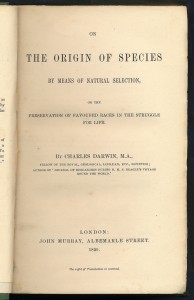Charles Darwin
Early Life
Charles Robert Darwin was born in Shrewsbury, England, on 12 February 1809. He was the fifth of six kids born to Robert Darwin, a doctor, and Susannah Darwin, a housewife. Charles Darwin attended Shrewsbury School, which was run by the Anglican Church. In 1825, despite protest, his father forced him to attend the University of Edinburgh Medical School, which was the best medical school in the U.K. at that time. He found the studies boring and stressful, and instead spent time with a freed slave named John Edmonstone. John Edmonstone taught Charles the art of taxidermy and often shared stories of his grand adventures through the South American rainforest. The lack of care towards the medical field greatly upset his father, and angrily sent him to Christ’s College in Cambridge to become an Anglican priest. During his time there, he developed a “burning zeal” to contribute to the growing number of scientific travels and explorations (Encyclopedia Britannica, 2010).
Voyage Of the Beagle
In 1831, Darwin left for a five-year journey onboard the H.M.S. Beagle. During the voyage, he spent a great deal of time investigating animals on the Galápagos Islands. The small group of islands 600 miles off the coast of modern day Ecuador contains species found nowhere else in the world. Studying finches, Darwin was puzzled as to why they had slight variations on each island, when only one species was known to live there. When he returned to England in 1836, he began assessing all his notes, drawings, findings, and samples (Berra, 2008).
He concluded that:
- Beak varieties were associated with diet typically found on that island
- When original finches arrived, they dispersed and had to adapt to different conditions
- Over multiple generations, finches changed anatomically in ways that benefited their survival.
Darwin’s Theory of Evolution
As he researched further, he learned that a population is made up of many individuals with slight variations. The ones with variations (or mutations) that are better adapted to the environment stay alive longer thus allowing them to reproduce more often. For example, the finches with beaks better suited to getting nectar from flowers or eating hard seeds had an advantage over the finches with beaks suited for eating cactus or worms. As the generations passed, nature “selected” the better suited to survive longer and allow them to reproduce more frequently than those that died off quicker. This process is known as natural selection. Simply put, the genetic variations that already exist between organisms allow the more popular traits to outlast the less popular or inferior ones. Darwin compiled this theory into a book titled On the Origin of Species, but did not publish it until November, 1859 (Padain, 2008).

Original On the Origin of Species
by APS Museum, used under ![]()
Effects of On the Origin of Species
The book proved unbelievable popular, with all 1250 copies sold on the first day. His argument was laid out in the introduction, and simply stated:
As many more individuals of each species are born than can possibly survive; and as, consequently, there is a frequently recurring struggle for existence, it follows that any being, if it vary however slightly in any manner profitable to itself, under the complex and sometimes varying conditions of life, will have a better chance of surviving, and thus be naturally selected. From the strong principle of inheritance, any selected variety will tend to propagate its new and modified form.
– Charles Darwin
The book received mixed reviews from both the church and the general population. Some attempted to declare his writings as proof of god’s “self-evolving powers of nature”. Others took it as sign to try and disprove the church’s teachings. Within the decade, the “Darwinism” movement began to gain support, with most scientists agreeing that evolution occurred. Most of these scientists did not, however, support Darwin’s theory of natural selection. He spent the remaining twenty-two years of his life with his wife Emma, studying plants and continuing to refine his idea of natural selection. On April 19, 1882, Charles Darwin died of heart failure. He was one of only four people outside of the royal family to be buried at Westminster Abbey (Encyclopedia Britannica, 2010).
It was not until after Darwin’s death that his works became the world-changing ideas they are today. His legacy continues today as:
- The basis for all of today’s biology
- Disease prevention depends on an understanding of evolution.
- Species management has evolutionary consequences.
- Paradigm shift in scientific thinking
Sources
APS Museum. (2008). On the Origin of Species. [Digital Image]. Retrieved from https://www.flickr.com/photos/apsmuseum/2784406910/sizes/l. Available under Creative Commons Attribution-NonCommercial 2.0.
Berra, T. (2008). The Legacy of Charles Darwin. Retrieved April 11, 2014, from Actionbioscience: http://www.actionbioscience.org/evolution/berra.html
Encyclopedia Britannica. (2010). Charles Darwin (British Naturalist). Retrieved April 11, 2014, from Encyclopedia Britannica: http://www.britannica.com/EBchecked/topic/151902/Charles-Darwin
Padain, K. (2008, March). Nature: International Weekly Journal of Science. Retrieved April 11, 2014, from http://www.nature.com/nature/journal/v451/n7179/full/451632a.html
Recent Comments